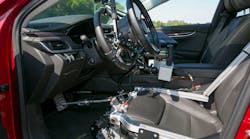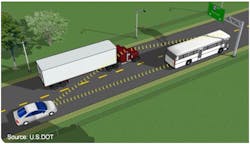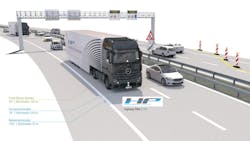A new report from Navigant Research predicts that annual sales of light duty vehicles equipped with factory-installed vehicle-to-external, or V2X, communication systems — in the past often referred to as vehicle-to-infrastructure or V2I technology — is expected to hit 70 million units by 2025, a market the consulting firm expects will be worth more than $25 billion.
“With U.S. regulators on the verge of mandating vehicle-to-vehicle (V2V) communications technology beginning in about 2020, the market for connected vehicles is set to take off,” Sam Abuelsamid, Navigant’s senior research analyst, noted in the report.
“As wireless communications become increasingly capable and ubiquitous around the world, connecting vehicles to each other, to other road users, and to the surrounding infrastructure will become increasingly important,” he explained.
“Toyota launched a V2V system based on DSRC in Japan in late 2015, General Motors is launching the first system in the U.S. market in early 2017, and Audi has a 4G LTE-based vehicle to infrastructure system on select model year 2017 vehicles,” Abuelsamid added.
Now, V2X is a bit of a different mousetrap compared to its V2V brethren, he pointed out, as V2X systems use dedicated short-range communications (DSRC) technologies as well as 4G and 5G cellular data communications networks so vehicles “talk” to things like buildings, street lights, etc., so they can achieve a better overall view of traffic volume and other roadway conditions.
Navigant also thinks a robust aftermarket market for V2X systems will develop as well, with retrofit kits and smartphones equipped with DSRC capability expected to be made available and ultimately adopted.
Why? because V2X is expected to be a “key technology” in Navigant’s analysis for reducing vehicle crashes and fatalities in the next decade, as well as creating a platform for the development of “robust” automated driving “ecosystems.”
That’s a view shared by Steve Sashihara, founder and CEO of Princeton Consultants – especially when it comes to self-driving trucks.“Our firm believes that self-driving trucks are going to get here faster and have more impact” than many currently think, he said in a recent conference call hosted by Stifel Capital Markets, because “there’s a very solid business case” for automating big rigs.
“Drivers are about a third the cost of long-haul dry van transportation,” Sashihara explained.
“When you think about a self-driving car, most of us are driving ourselves, or maybe our families around, so when the thing is self-driving what’s the business case, besides having a new, cool gadget? I guess I could read a magazine while it’s driving me around, and certainly, if you’re handicapped, that’s a good business case,” he pointed out. “But for most people, we’re commuting to work, to school, and so the fact that I don’t have to keep my eyes on the road is not a terrific business case.”
On the other hand, in commercial trucking, the driver is a huge part of the cost and the hours of service (HOS) rules for the driver really limit the use of tractor utilization. “While there is some slip-seating that goes on in our industry, that’s more the exception of the rule as most of us know. Particularly with a lot of owner-operators, when they’re not driving, they are sitting there,” Sashihara noted.
“Precisely at the times when the rest of us would like to see the tractors on the road are the worst times to drive in terms of driver distraction or because of fatigue at night,” he emphasized. “Whereas with robots, I think they would be happy to drive at night and have better speeds and utilization.”
Getting to that fully autonomous vehicle stage in trucking, however, requires several stepping stones – and connected vehicle technologies like V2X and V2V systems are one of the first stones needed.“We see basically self-driving trucks in the commercial space in three phases, the first which we’re seeing already: truck autopilot, which assists a traditional driver still in the seat,” Sashihara explained.
The second – which he said will occur faster than many people think – is the operation of partially self-driving “pelotons” of trucks driving up and down the highways. “Think of this as the ‘new intermodal,’” Sashihara noted. “You’ll be doing the first and last mile deliveries using different vehicles, using essentially drayage, then short-haul regional trucking, then back to drayage.”
Finally, the third phase: a complete door-to-door driverless truck solution.
Now, Sashihara noted that many in trucking get “hung up” on the self-driving truck concept when thinking about tasks such as backing up to freight docks.
“They’re saying, ‘look, have you ever seen a truck back into a dock, have you seen how many docks are in a crowded city? Can a robot really do that?’ But the nice thing about option two is you don’t have to worry about that,” he explained. “You can have a human driver pick up and exchange [trailers] like in a standard drayage move,” with only the “long-haul” portion of freight moving up and down highways handled by autonomous trucks, Sashihara added.
When is this all going to happen? Well the influx of V2X and V2V technologies into all motor vehicles, not just big rigs, will help spur this dramatic shift to driverless trucks in freight transportation. But it won’t be a smooth nor necessarily obvious-to-the-naked-eye shift either, Sashihara argued.
“Here’s a quote I love: ‘The future is already here, it’s just not very evenly distributed,’” he said. “It’s hard to say this is the moment which Steve Jobs walks out on stage and lifts up the iPhone and suddenly the world shifts. Before he walked on stage you had the Palm Pilot, you had the Blackberry, you had lots of other things that looked like what he did, so there might not be a big inflection point for any of these technologies. But they are coming very quickly.”
Very quickly indeed.





